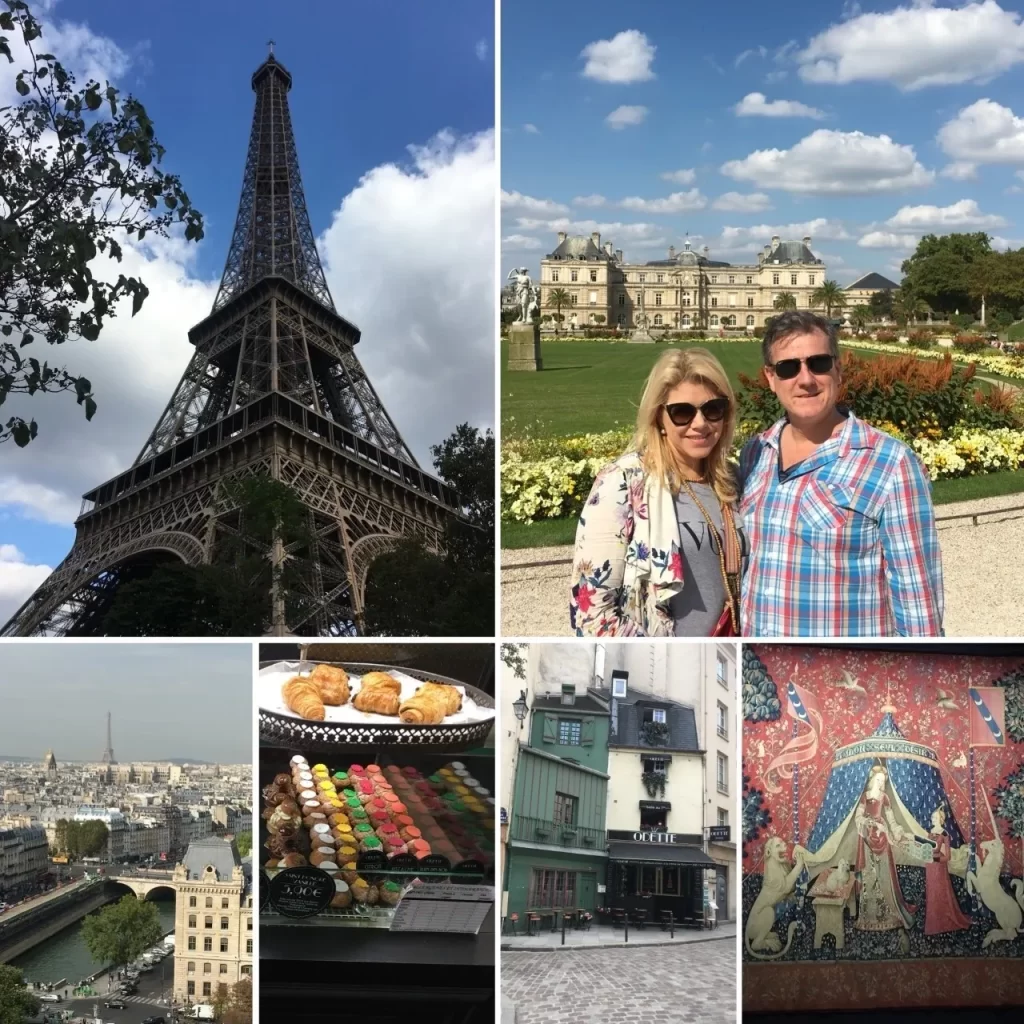Planning ahead in Paris can make for a calm vacation with all your bucket list ticked!
Loulabelle's FrancoFiles episode 67
Other Loulabelles links:
Loulabelles FrancoFiles Instagram
Loulabelles FrancoFiles Spotify Playlist
Loulabelles FrancoFiles Facebook
Lately I’ve been hearing more and more from Loulabelle’s FrancoFiles listeners that they are making plans to head back overseas and to France! It’s been such a long time since many of us have travelled that I thought an episode about travel tips to refresh our memories would be une idée fabuleux!
Below is a list of things I always consider when planning a vacances en France…
1. COVID
Across the world there are changed travel conditions that differ from country to country and may even change from month to month or in some places week to week! So of course the first thing to do before leaving is check the COVID compliance matters such as testing prior to flying, isolation, vaccination, etc.
2. Accommodation style
One of the first things to think about when in the planning stage of your intended holiday is whether you wish to stay in a hotel or an Airbnb. I love Airbnbs as I feel for a moment like I’m living like a local. Also when staying on extended trips it’s nice to be able to cook a meal and eat like we’re at home as well. I actually find it fun in France to go to the petit supermarché and buy local brands of things that differ from what we can get in Australia and then make a meal with those.
So whilst we can’t cook for ourselves in hotels, there are other great reasons for staying in them. If your French language skills are more on the beginner side, a hotel can provide a terrific resource. When travelling alone some tourists find having a concierge is a great safety measure as is an in room safe. But for me, I always stay in a hotel on my last day when I have a late flight departure back to Australia, as a hotel gives me a place to store my luggage for the last day of sight-seeing and while I’m out and about.
3. Time saving, skip the queue and crowds
The Paris Pass gives entry into loads of Paris attractions that are certain to be on any Francophile’s bucket list, but the best thing is that with the Paris Pass there’s no need to queue to get in to the museums or attractions and you can just walk right on through! When staying in Paris for a few days or a week, most people don’t wish to spend much of that time lining up! It is important to purchase the pass before you depart for your trip.
Now there are some places you will not be able to avoid a queue and a little bit of a wait, but there are ways to reduce that wasted time. If going to the Eiffel Tower, booking a guided tour that is in the Paris Pass will help reduce waiting time, but if going up the tower in the usual way, getting there first thing in the morning before the crowds is a great idea.
Another place that has loads of crowds inside is the Louvre, especially around the Mona Lisa. I have always found the Louvre to be extremely quiet around 5.30-6pm on a Friday night so it is worth checking the evenings that it is open during your Paris stay and planning your visit then.
The Palace of Versailles is also a place that attracts hordes of crowds, but you will find it pays off to get there early as even with the Paris Pass you will be required to queue here. On each visit I have arrived a good half hour before opening to go to the ticket office and get my tickets with the Paris Pass and then head to the queue. An extra tip for visitors to Versailles, you might want to set aside a whole day to visit. In addition to the palace there are the Grand Trianon and Petit Trianon to see. These are the summer houses for the king and queen and are exquisite and well worth extending your visit to see.
Now the Paris Pass used to send to your home address prior to departure all the required cards that you need to show to be admitted at attractions as well as a little guide book of all that’s on offer, but now it has changed to an online arrangement. I’ll let you all know what I think of this later in the year when I have been back to Paris try it out, but so far I’m a little disappointed. Mainly as now to get the pass for access to the museums, there are two separate parts to the pass, one for museums and one for other attractions, it is now necessary to visit their office in one spot in Paris. This will cut a little chunk into the schedule and might be worth factoring into the itinerary.
4. Shopping and taxes
On each trip to Paris when I have used the Paris Pass there has been a treat on offer at the Galleries Lafayette specifically for Pass holders. Last time it was a tote bag which I still use every day! A little advice for shopping at the Galléries Lafayette, as a foreigner heading back to Australia, we can claim the tax back on our purchases. It is a little complicated and I have not often got the process sorted successfully, but for a start it will help enormously if you remember to take your passport with you when shopping there as it will be needed to submit the tax claim forms. It can really add up if making a number of purchases so it’s worth doing, but it is a fiddly process, so ensure you check out what’s required before starting your shopping.
5. Sim cards with unlimited data
My number one tip for travel to France in the era of requiring data! If you seem to have issues with sim cards when you travel like I do, even the ones I have purposefully purchased online for the trip, then this is a tip pour toi! On one trip I spent days on end phoning from a hotel phone to the supplier to get it to work, only to end up going and purchasing another sim locally. But on subsequent visits I have always gone straight to the Tabac next to “Esmeraldas” just across the road from the back of Notre Dame facing the Seine. I buy a sim there that is for a number of weeks for use just in France. I actually take my regular sim card out on the flight to France and just use wifi when I get to Paris in the airport until getting the new sim which has unlimited data to use anywhere in France. Unlimited data is priceless in this online world! Using data I can make calls to home via apps like Facebook Messenger, I can look up travel details on the internet and can check emails or any other online needs that are accessed on my phone. There’s no need for a phone number as I just use all my own apps on the phone with the sim providing the data.
6. Itineraries
It is not common that people travel as a tourist to Paris on their own. I have a couple of times but then some people might suggest I’m just a little bit obsessed! It’s important if you want to make the most use of your time, to set up an itinerary of sorts while still at home. But if the style of vacation is one of laid back immersion, perhaps locking into an itinerary is not so important for you. Often tourists will be travelling with a partner or a group of family and friends, so I suggest especially if this might be your once-in-a-life-time trip, getting everyone’s top 3 or even top 5 things they must do in Paris. Then it can be beneficial to group those attractions into arrondissements so you’re not going backwards and forwards from one side of Paris to the other everyday! Your travelling group can spend the day or even just a morning or arvo in the one arrondissement and checkout all the things on the bucket list for that area. This makes most use of time but also leaves tourists feeling less exhausted with less travelling.
It’s important to keep the itinerary flexible in some ways to account for rainy days, or other last minute required changes, but there will be bookings you may make prior to the vacation that will need to be factored in and worked around.
7. Planning for regional France
Consider the length of time you are intending travelling through regional France. Is it a short quick trip to one region or are you spreading your time over a few months? What season are you travelling in? Do you prefer the heat or like me are you a fan of cold crisp days? If travelling over some time and across France, think about whether to start from the south and finish in Paris or vice versa. So for example if travelling in spring through March, April and May and if you’re not crazy about the heat, you might wish to start your trip in the south of France where it’s milder in the spring and head north or into the mountains as the months heat up getting closer to summer. Your chosen fave temperature can be a big factor in deciding what region is right for you at various times of year.
8. Car hire, train or a bit of both?
For Aussies or for other countries where we drive on the left of the road, driving in France might seem like a stressful matter but it doesn’t have to be. I haven’t driven in Paris and I don’t necessarily recommend that as it is incredibly busy compared to Australia, but in the country side there is the space to get used to the opposite way of driving. Once you stop trying to get into the passenger seat to drive which I’ve done more than once!
Now to get out of Paris I almost always catch a train. The TGV is so quick and the train links in France are very efficient. Gazing out over the French countryside is very therapeutic during a vacation too. Make sure you are early for your train from Paris, and stand on the platform in line with the carriage written on your ticket. At some platforms the corresponding carriage letter will be marked on the ground. Then getting onto the train is something that needs a bit of forethought. The passengers all getting on will clamber for the luggage stow section near the door all at the same time! If you’re not one of the first on you will need to store your luggage in another carriage which could be half way down the train! I prefer to keep my luggage where I can keep at least half an eye on it so I ensure I’m on board swiftly to get luggage stowed and then into my seat! If catching a connecting train the disembarking and re-boarding process can sometimes be crazy busy too, so be prepared to move swiftly! When travelling with some girlfriends to the Dordogne some years ago we caught the TGV from Paris to Bordeaux and then another train from Bordeaux to Bergerac. The changeover between trains was 3 minutes! It was stress city as we had to change platforms and there wasn’t a lift to help us with all our luggage! This could have been made easier if we had closely checked the amount of time between connections on the ticket. We had no idea how it all worked back then!
It’s hard to travel to more places than villages with a train station if you don’t have a car in the French countryside. When hiring a car I recommend not choosing the big roomy option as it could be a challenge getting through some of the narrow laneways in the ancient villages. In saying that it’s important to not go too small or you won’t fit in all your luggage, so with car hire I always do a bit of a Goldilocks and go the middle size which is just right! I’ve mentioned a couple of times before that extra care should be taken when hiring cars from railways stations. Some towns have more than one station so always double check the actual address of the car hire against the station on your ticket and pay particular attention to the names as they can be quite similar. Lastly with car hire, check out the car parking situation when booking accommodation as even though there is lots of space driving through the rolling hills, little country villages can be tightly packed. It’s part of their charm, but it doesn’t result in lots of car storage options!
9. Les Plus Beaux Villages de France
I have discussed the Plus Beaux Villages de France a few times on the Loulabelle’s FrancoFiles podcast and that’s because they’re just so wonderfully exquisite! I have been to a few and each visit was like stepping into a dream! The Plus Beaux Villages de France are select villages that have been designated amongst the most beautiful in the country. Each of the villages must meet certain criteria which is fairly strict. There must be rural character with no more than 200 inhabitants and there must be at least 2 national heritage sites. The local council needs to approve the application to be a Plus Beaux Village and an on-site evaluation has to take place. It really is quite rigorous, but the result is a list of some extraordinary villages across the whole of France.
10. Other considerations for choosing villages/regions
When deciding which regions or villages to visit, there are a few other considerations:
- Do the market days in the village coincide with your visit?
- Checks dates for local festivals to ensure you don’t miss out if local country festivals are your thing, or so you can avoid them if they’re not!
- Book ahead for tours and special local knowledge sessions such as wine tours, special lunches or cooking days and work the rest of your regional stays around them.
11. Start the immersion before you leave home!
When starting planning for a trip to France, try and get your French immersion kicked off at home. I have interviewed a few French teachers here on the podcast in Australia and in France who offer different types of French lessons in varying formats. Even watching French movies or television or listening to French music can started getting you connected. I have a fabulous Spotify playlist of French music that will definitely get you started. I have compiled it from the suggestions of all the podcast guests and today I am going to add my latest fave that I will have playing as I pack my suitcase for Paris this year!
Musique
Maison en Papier Guilio Cercato (vocals by Victoria Richard)



